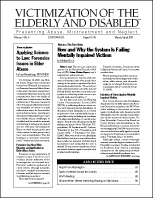Prison Rape Elimination Act Looks At Elder and Disabled Sexual Abuse Behind Bars
Author: Loree Cook-Daniels M. S..
Source: Volume 15, Number 05, January/February 2013 , pp.67-69(3)

< previous article |next article > |return to table of contents
Abstract:
In the October days before Jerry Sandusky, age 68, was sentenced to at least 30 years in prison for committing sexual abuse against 10 boys over a decade’s time, The Associated Press and its subscribing newspapers ran a long article asking how likely it would be that Sandusky himself would be raped in prison, and whether those (projected) assaults should be considered a fitting part of his sentence. Public opinion may be divided, but the federal government recently has come down firmly on one side of the issue, in May 2012 issuing a long-awaited, comprehensive set of guidelines for the Prison Rape Elimination Act (PREA). PREA was originally passed by Congress in 2003, and the fact that it took nearly a decade to publish the 268-page final rule on how it is to be implemented suggests just how complex, controversial, and comprehensive the effort will be. In 1996, the ABA House of Delegates recommended 29 guidelines for state courts.Keywords: Jerry Sandusky; Prison Rape Elimination Act; PREA; old and disabled behind bars; inmate access to outside advocates; ABA guidelines for state courts
Affiliations:
.